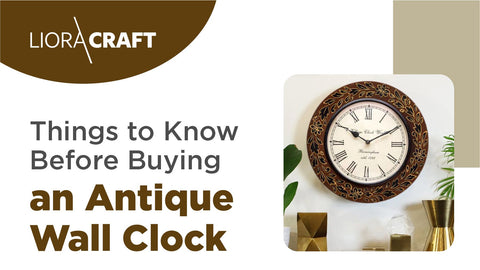Antique Wall Clock
Antique wall clocks are great for any decor because of its history, craftsmanship, and beauty. Antique wall clocks can make your home, dining room, or office look better. This is when you collect them, are interested in history, or want to decorate your property giving it a touch of heritage. Get a real antique wall clock that works.
Why Buy an Antique Wall Clock?
Antique wall clocks are charming and useful as well. Antiques is a term that hints at telling past stories and can easily stand out with its intricate craftsmanship, unlike modern clocks. From elegant brass to finely carved antique wooden wall clocks, they may enrich any environment. This is where they generate talks, especially a living room. Your home gets character from each clock's patina, history, and originality.
Antique wall clocks are beautiful yet heavy. Usability depends on age, condition, and rarity. You may buy an expensive, damaged, or non-antique clock without knowing. These qualities are crucial for buying knowledge. You should consider many things before you buy an antique wall clock. Many collectors consider anything over 100 years old antique but some include early 20th century.

Types of Antique Wall clocks
Mechanisms and styles vary in antique wall clocks. Knowing these types may help you choose a clock that complements your decor. Popular types:
Early wall clocks included the 17th-century "wag-on-the-wall" weight and pendulum clock. Weight on a chain or cable powers the clock. The exposed gears and rustic look of these clocks make them ideal for farmhouse or traditional living spaces.
Oak, walnut, and mahogany antique wooden wall clocks are valued. Some antique wooden wall clocks have hand-carved, inlaid, or painted dials. Warm, organic style was prominent in 18th- and 19th-century Europe and America and remains.
Vienna Regulator Clocks have elegant, expanded cases with weights and pendulums. Roman numerals and elaborate dials make them wonderful living room decorations.
In the 19th century, springs replaced weights, allowing smaller wall clocks. Beautiful casings make these clocks easier to maintain than weight-driven ones.
Mechanical birds tell time in quirky German Black Forest cuckoo clocks. Antique 18th- and
19th-century cuckoo clocks are valued.
Clock models vary, so choose based on style and display space. Ancient oak wall clocks are warm and classic, while cuckoo clocks are funny in unconventional living spaces.
Evaluation of Condition & Authenticity
Checking antique wall clocks online or at auctions for condition and authenticity is vital. Consider these critical factors:
Clock mechanism test: Aged wall clocks need regular winding and mechanical repair. Is the clock new or used? Ask the merchant. Working clocks are worth more, but over restoration damages them.
Fabrication, craftsmanship: Examine clock materials. Vintage oak or walnut wall clocks have grain and patina. Uneven cuts or tool marks on components indicate pre-industrial production.
Wear: The clock has character from scratches and fading paint. Missing or damaged dials impact value and operation. Perfect clocks may be bogus.
Maker's marks: Many antique clocks contain maker's marks or names on the dial or movement. Researching the clock's maker verifies its age and legitimacy. Seth Thomas and Ansonia produce good vintage clocks.

Where to find Antique Wall Clocks?
Many vintage and internet businesses sell antique wall clocks. You may find vintage wall clocks on eBay, Etsy, and Liora Craft. Before exploring worldwide clocks on these marketplaces, verify the vendor and clock. View seller reviews, descriptions, and high-quality photos.
Local antique and auction shops carry wall clocks. Ask the clock's history in person. Some small auctions find gems, whereas Sotheby's and Christie's sell luxury timepieces.
Antique wooden wall clocks at estate sales and flea markets. Differentiate antiques from reproductions. Check maker's marks and age with a magnifying glass.
Focus on clock expertise and unique collections. Professional collectors trust clock history and condition.
Skip incredible online savings. Request images or documents to verify the clock's authenticity before buying.

Maintenance and Care
Antique wall clocks need regular maintenance to stay valuable and useful. Here are some tips:
· Vintage clocks are wound daily or weekly. Follow manufacturer directions or consult a clock maker to protect mechanisms.
· Clean the clock with a dry cloth. Do not use harsh chemicals or water that damage wood and finish. Use high-quality furniture polish sparingly to shine antique wooden wall clocks.
· Maintain the clock mechanism every few years. Maintenance includes cleaning, oiling, and replacing clock parts. Avoid direct sunshine, humidity, and temperature changes to safeguard the wood and mechanism. In a living room, keep an antique wall clock away from radiators and flames.
· Insure expensive clocks against theft or damage. Purchase, origin, and appraisal of insurance claims.

Arbor Vitae – The Eternal Tree of Time
Conclusion
Charm your home with vintage wall clocks. Buy a clock knowing its type, condition, and authenticity. Internet marketplaces, antique shops, and specialty vendors can help you find an antique wall clock within your budget. Beautiful antique living room wall clocks give time and stories for decades.




